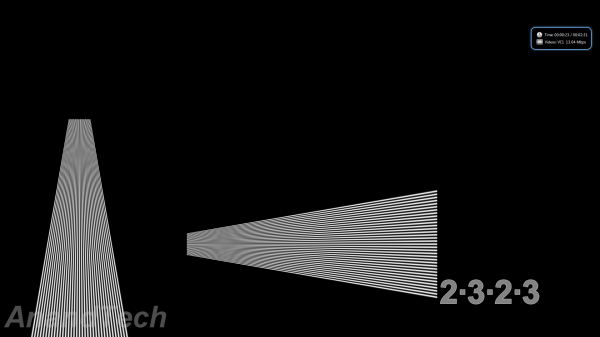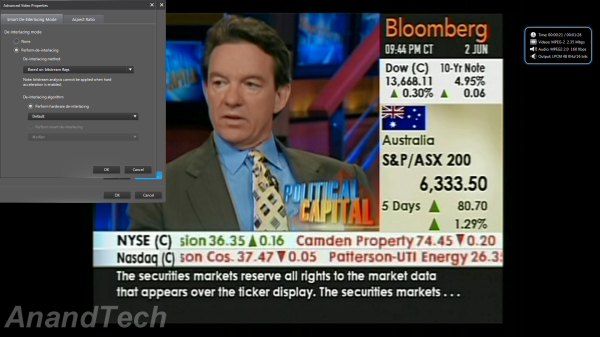VIDEO POSTPROCESSING IN 'ACTION'
HQV scores are meant to be a quantitative metric, but some of the aspects deserve further coverage. In earlier reviews, we had provided screenshots of the Cheese Slices test in order to show deinterlacing performance, and in the Llano review, we looked at issues with the chroma upsampling algorithm. In this section, we will see how the GT 540M fares.
Cadence Detection:
The GT 540M obtains the maximum possible score for cadence detection in the HQV benchmarks. But, is it really effective in all cases? We took the Spears & Munsil Wedge Pattern clip for a test drive. The same test clip was used in our Discrete HTPC GPU Shootout piece. In the previous test, only the GT 430 was able to perfectly inverse telecine the clip. The GT 540M managed to retain that ability.
However, some of the other cadences (including those for which the HQV clips were processed correctly) were not properly inverse telecined / deinterlaced. The gallery below provides information on the troublesome patterns.
In addition, videos often have overlaid text which might be of a different cadence. The 'shredded text' resulting
from the video processor being unable to do local cadence decisions often ruins the experience. Some GPUs (like Intel's HD Graphics 3000 in the ASRock CoreHT 252B) take more time to lock onto the cadence compared to others (such as those from AMD). Unfortunately, the GT 540M belongs to the former category. It has problems with both horizontal and vertical scrolling text for more than 5 - 10 frames before locking onto the local cadence.
Deinterlacing:
Instead of the Cheese Slices clip, we have a new deinterlacing testclip (a 480i MPEG-2 stream that we first used in the Zotac ZBOX Nano XS review). As expected, the Vision 3D 252B had no trouble deinterlacing this stream. Further down in this review, we also have rendering benchmarks which show how much the IVTC (inverse telecine / cadence detection / film mode detection) and deinterlacing operations load up the GPU.
We also processed the boat clip from the Spears & Munsil disc, and to tell the truth, there is not really much difference in the quality of deinterlacing that we see between AMD, NVIDIA and Intel. All that matters is whether the GPU is powerful enough to deinterlace content at a given frame rate and resolution, and suffice to say that the GT 540M has no problems even with deinterlacing 1080i60 content (as we will see in a later section).
Chroma Upsampling:
The HQV CUE / ICP testclip was used to check up on the chroma upsampling quality of the drivers. In the gallery below, you will find three screenshots taken in the course of playback (one with PowerDVD, one with ArcSoft TMT and the other madVR set to Softcubic (Softness 70) chroma scaling. Though one can say that the madVR output holds the slight edge, it looks like the algorithm used in the NVIDIA drivers is no slouch
Noise Reduction:
The gallery below presents the noise reduction algorithms in action. Noise reduction strength can be set between 0 and 100, and the gallery below has screenshots for 0, 50 and 100 noise reduction settings for each segment of the clip. The noise reduction algorithms work decently, but the difference is not as stark as, say, what one gets with the AMD GPUs when mosquito noise reduction is enabled.
Contrast Enhancement and Skin Tone Correction:
Simply put, the dynamic contrast enhancement and skin tone correction options in the NVIDIA Control Panel do not work. The gallery below presents the necessary proof.
The color tab in the panel has a contrast setting, but that affects the picture as a whole and doesn't work in the manner that the HQV benchmark guide expects it to. Color enhancement is supposed to take care of skin tone correction, but that was quite ineffective too. We remember seeing the dynamic contrast feature working in a previous driver version, and this just goes to prove that NVIDIA is as guilty of breaking HTPC features in their drivers as AMD is. That said, the driver version v301.24 we tested with is not WHQL certified (I had to move up from v296 because there were some graphics driver stability issues in my setup while testing various HTPC aspects). So, we are willing to cut NVIDIA some slack. However, we hope that NVIDIA is aware of this issue and will take steps to correct it based upon user feedback.



























